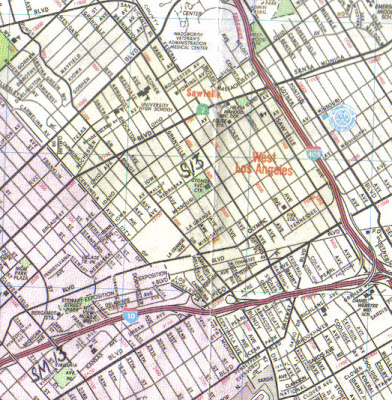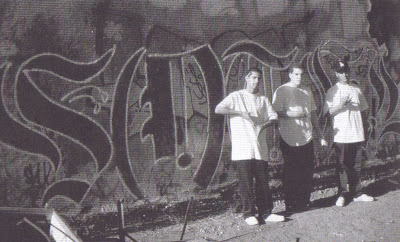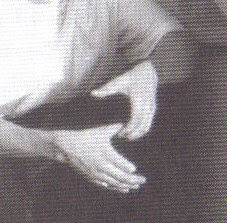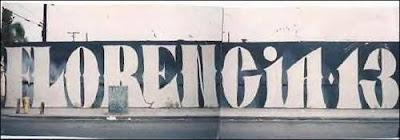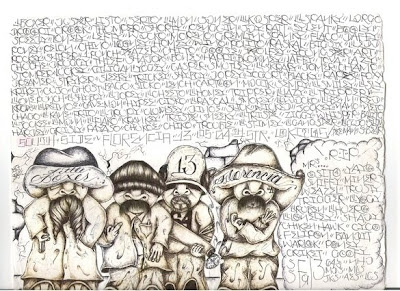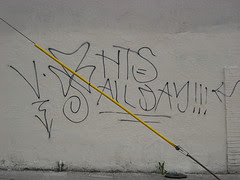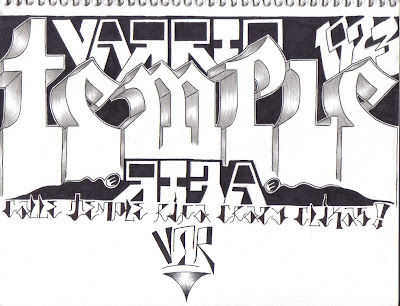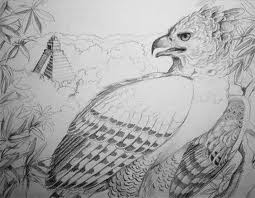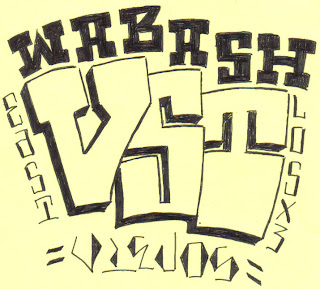Gangs of LA; The Origin of La Mara Salvatrucha
It’s not that the shot-caller from the Fulton Locos clique was anything for trucing, in fact, he hadn't acquired the moniker of Satan for promoting any types of peace pacts with the enemies.
Satan was the shot caller of the MS13 clique in the San Fernando Valley. He was born Ernesto Deras. At first appearances Satan looked like the typical Salvadoran immigrant, a skinny twenty something young man with very little facial hair, and of small medium stature. He was sort of quiet and reserved, he spoke with like a tired voice, slow and deliberate, almost like a slurred-whisper, but never one to be loud; those who knew him could tell you that they never heard him be a loud-mouth, not even to have heard him bust out in laughter; he appeared to be someone caught in an infinite sadness. Satan wasn't much of a Rambo type figure but he had received U.S. Special Forces (Green Berets) training with the Salvadoran Army Immediate Reaction Battalion. Satan could dismantle and put back together all types of weaponry; He knew combat tactics and ambush set ups, he had trained in small unit operations, and he understood the strategies that go with the importance of holding ground (holding down turf); he had received some of the best military training while with the Salvadoran Army, and it was precisely his military abilities that converted him in little less than a year’s time, into the shot caller of one of the strongest MS13 cliques of the times. To say that is no small feat, because within the street gang world protocols, almost no one goes from a jumped-in initiate, into one who calls the shots for a clique within the time span of one year, -unheard of in most circles.
Satan had come to the U.S. like most other Salvadoran immigrants, -fleeing the civil war. He had arrived here like most, hidden and scared like a overcautious animal. But Satan had been trained for war, and most likely had already been in plenty of action, so he was not one to easily peace up with the enemies; that is why in 1993, when a few top ranking homeboys from his gang approached him, they tried hard to explain to him and convince him to attend the meeting that was to take place in which members from La Eme had set up to square things up; they had to convince him that this was a serious matter, and that the Senores de La Eme were best not to be reproached or given a bad face.
The MS gang to which Satan had incorporated himself into, at the time was considered an outsider gang, not within the system. It operated outside the Eme structure, so it had to either be brought in, or it had to be dealt with, with extreme prejudice.
When the Salvadorans started arriving en-masse to California during the late 70s and 80s seeking refuge from the horror of the civil war which engulfed their homeland, the Mexicans and their descendants in LA, the Chicanos, they already had decades of having organized themselves into gangs; they had organized in part to make an affront to the ruling white-Anglo society. They fought against the discriminating forces of society; and yet they themselves were not pre-disposed in extending a welcoming mat for the new Salvadoran population arriving to the barrios of LA. That’s why when these young Salvatrucos formed their own gang, it was in large part to deal with the black and brown menace set against them in the city. The Chicanos looked down on the Salvadorans, and they saw the MS gang as an aberration, something not from the old structure, even something to puke about.
It wasn't easy for MS to be the new gang on the block, and it was all made worse by not being of the same ethnic or national background like the Chicanos. But just like in any ecosystem, the creature learns to adapt and survive; it is necessary to learn fast who eats who in the wild. When MS appeared on the scene, they had already realized the long established fact on the streets, and that was that each gang can be either the victim or the predator, and in that same street system, in that food chain, there was only one at the very top; the Mexican Mafia with its shot callers whom after all is said and done, they were the ones who decided who could play in the larger scheme of things, and who didn't. MS up to that time could not play; they were as yet not in the Sureno camp.
Satan had begun to be the shot caller for the Fulton Locos in 1991. At that time the Fulton Locos was the only MS clique in the whole San Fernando Valley. During that era, there were some 75+ gangs in the valley, and each were at war with their own respective enemies, but they all had as a common enemy La Mara Salvatrucha.
In knowing that the MS Fulton clique was the universal enemy of all the SFV gangs, it created a mindset within the Fulton Locos which hardened them and turned them into a very vicious and violent clique. Those years of being on everybody’s scope made them not trust anyone, and that’s why in 1993 when Satan was approached with the invite to attend the meeting of SFV gangs, his military and street sabe instincts told him that it could be a trap, and to plan a way out; to have an exit strategy, or at the very least -in a worse case scenario- to ensure that the MS Homies de La Fulton would not be the only ones ending up stretched out on the streets because of an ambush.
On Halloween night, 1993, two mediators were able to bring together for the first time ever, dozens of SFV gangs and drew them to a meeting at a park in the Pacoima neighborhood. Not one single violent problem occurred during that first meeting.
The mediators were the ex-kick boxing world champion, William “Blinky” Rodriguez and his socio Big D. They had been compas since infancy, and both had been players turned born-again Christians. After their conversion, they had embarked on a mission to bring about a peace treaty between all the gangs in the valley; an absurd idea; a doomed crusade, or so it seemed to most heads at the time. But this celestial business had a darker side since both of them had gotten a greenlight from La Eme to gather up the gangs, and La Eme had even assured them the co-operation of the gangs shot-callers. In essence, the Black Hand flag was behind the meeting.
At the meeting, Blinky and Big D preached to the gangs the Good News of The LORD, and invited them to get closer to GOD; they also wanted them (the gangs) to try and resolve their problems through communication; to talk with each other.
And so it happened that the attending media looked at all of that with raised eyebrows and skepticism; they just could not believe what was taking place right before their eyes; it seemed that the impossible was becoming a reality.. From that day on meetings began to take place on the regular every Sunday. As it was expected, La Mara Salvatrucha was the last gang to get an invite.
Satan had been aware of the meetings taking place, and he knew that the invitation for his gang was soon coming; that it was in the works.
SATAN
“They came looking for me; they caught my attention and made some sense to me, so I told them alright, we’ll go, not to make peace, but so no one would say that we were scared to go. I told them that we would be there for next Sunday’s meeting, but they said to hold up some; that they had to go and prepare things, make it alright for us to go in there without a hassle.
We threw a meeting and I said to the Homeboys that it looked like the Eme jefes appeared to be behind this all of it, but that just in case it wasn’t all right, to make sure they took their cuetes with them, nomas.
We were the last ones to arrive at the park, something like 30 of us went in, and another ten or so stayed outside; those outside had the fuscas, and they knew what they had to do in case things didn’t work out right. The gang of us went in there saying, salimos o no salimos!
The park was full of gangs, and everybody stood up and took notice when we walked in, some of their homeboys right away started talking shit, but nothing happened. There was a lot of media there, and when they got word that it was La Mara walking in, right away they focused in on us. But the Homeboys blew them off, and didn’t respond to their barrage of questions; neither did they pose for pictures like they wanted us to. One of the event organizers asked me to remove my lid out of respect.”
Just so as to be real clear to everyone there, who it was that they would be talking to at the meeting, Satan had walked in there all dressed down, and on his lid it read “fuck everybody.”
The Fulton shot caller had gone in to that park with an attitude of defiance. Blinky worried that the words on that hat would spark up some serio pedo, so he asked Satan –with the best manners and words possible- for him to remove his hat. El Satan agreed, without giving it that much importance.
And so it was that first day of peace for La Mara Salvatrucha.
There are those in the generic world who believe que La Mara Salvatrucha was born on 13th street, west side of downtown LA., Even the presidente of El Salvador, Mauricio Funes, has said it in public without a blush. The problem is that 13 street doesn't exist on the west side; in its place –in this huge metropolis filled with avenues, streets and alleys filled with gangs- is the exquisite Pico Boulevard running parallel in-between 12th street and 14th street which appears and disappears from block to block on the city map grid; symbolic of the restructured and redeveloped city landscape, but there ain't no 13th street there.
Then there are those who believe que La Mara broke off from 18 Street due to some internal problems. That’s how it happens many times in the world of great promises and in the streets of glory where fragile loyalties exist, and all the gangs live under that everlasting reality of dealing with their own internal politics which at times break them off each other.
18 Street itself was born at the end of the 1950s; born out of a rift (fracture) with the veteran C14 gang. Clanton 14 was born in the early part of the century, and by the 1920s, they were a well-renowned force on the streets of LA., C14 is one of the oldest LA gangs still keeping it going, both in the city, the state and even in the far-wide spaces of the continent.
But none of the MS history was like that, because in fact MS was not a break off of 18 Street, and neither did 18 Street spawn it. The true fact about the 13 in MS13 is plain and simple; allegiance to La Eme y nada mas! Eme being the Lords of ALL the Southern Califas Latin street gang system.
MS was late, very late in getting their 13 stamped on, but it was because they had done well without it for a long time; a decade’s time. They hadn't cared for it, and they felt that their attitude and numbers could hold them up forever.
In the late 1970s La Mara were just bands of disorganized Centros; raggedy heavy metal rockeros doing drogas. MSS fell in with the label of the times – Los Stoners- same as many others around the city like the Mid City Stoners and The Hole Stoners from East Los. Los Stoner groups were everywhere; smoking, toking, drinking, puro jugo y mota and whatever. The Stoners were at every barrio park in the city!
In those early years not one of the Mara Stoners was above 18 years of age. Most Salvatrucos had in fact just barely arrived here. They had landed here clinging to their jefitos pants and chuyitas skirts; running from the war back home; running away from the pobreza. They were among the most recent arrivals to the great big City of Angels, and as yet, they could not even claim a piece of corner concrete; much less, claim any territory. The streets they landed in were filled with Afro-American or Mexico-Americano gangs.
Even to this very day, to speak of the Mara Stoners is to invoke the pure unequivocal and most authentic history of the gang. Inside La Mara those still with the hazy memory of early history will still pass it down going back to the Pico Union and Westlake neighborhoods starting out as the MSS –Mara Salvatrucha Stoners- the original gangsters who got it together. All those first originals; all those early first players, none of them remain alive, they’re all gone, they’re all D.E.P. (Descanza En Paz).
That is the prestigious inheritance in which every initiate is jumped-in to. That is the conscientious worded tradition of the varrio, as it is passed down. Not no break off from Eighteen Street, not anything else but a pure Salvatruco Stoner background having to step it up and do battle for survival. That is straight Mara Salvatrucha pride!
Hazy histories are somewhat on the regular in the Lore of the Barrios, but it is well documented in LAPD records; the memory of the MSS groups going back to the year 1975, and even UC investigator Tom Ward vouches to the existence of MS crowds forming the nucleus of cliques, as early as the year 1978.
But there’s really no set time stamped for the start of MS; Some of the oldest still walking the earth Salvatrucos attest to the fact that at the end of the 1970s, the original crowd hanged out at the 7-11 at the corner of Westmoreland and James Wood (9th Street). That was the very first organized clique of La Mara Salvatrucha; some dozen Stoners who habitually kicked it at the spot. The names (monikers) of the original crazies are somewhat blurry, and yet even to this day, whether in El Salvador or LA, the Westmoreland Locotes still jumps in vatos into their clique. Traditionally, that was where it all began.
A lot of the young Salvatrucos had nothing more going for them other than rock concerts and to raise their fist in locura, throwing up the devil horns. That was it, no mas!
Salvatrucos back then considered themselves nothing but rockeros (stoners). They wore torn-up jeans, long hair and t-shirts with heavy metal rock bands lettering on them. They considered themselves like every other white or rocker kid on the American continent; a rebel of society. Mara Stoners would get into fights with other kids that acted and dressed up like themselves. They did 459 audible, stole from cars, and some even committed 211 silent to support their needs, and they began to build up for themselves a bad ass reputation at the local schools like Berendo Junior High. Berendo is just like 4 blocks away from the cross streets of La Pico and Normandie; the heart of Immigrant El Salvador.
Nearing the Spring of 1984, the start of the LA Olympic Games was about to happen, and City Hall implemented an undercover program to rid the streets -on the west side and south central- of any undesirables. Everything and everyone who did not fit in with the picturesque neat city image that was portrayed to the world had to be removed or scooped up and locked up.
In the midst of the Cold War era, in a planet with the shadow of nuclear holocaust looming overhead, LA represented a West versus East showcase, and nothing that detoured from that view was to be allowed to be seen. The City of LA had to present a scene of peace and security. The gangs had to be cleaned up from the streets, even if that was only for a few weeks time span.
The streets became like militarized zones with Police roadblocks and check points erected everywhere on the regular and street sweeps conducted on a nightly schedule. Dragnets happened all the time and all the habitual suspects were rounded up to be sent away for the summer. And the biggest and hardest black or chicano gangs were the first to be targeted. They were top on the list of the hidden agenda.
By the start of the Olympic Games the LAPD had decimated the gangs. The system had locked up so many of the hard cases and driven away so many others that it was scary. Shot callers were the first to go. Left without its main membership the Chicano gangs in the years of 1984 and 85 not only had to grapple with their internal clique problems, but they also had to duke it out with thee many other new up and coming neighborhood ethnic gangs like La Mara and AP. The void created by PD Special Forces all played out to La Mara’s benefit. La Mara then began to get organized and to install itself. La Mara of those years did not suffer the targeting by those same Police forces, neither did they suffer the internal conflicts of the established system in the gangs. All they (MS) had to worry about was to get Guanacos on board and organize them solid.
So without their main heads and solid gente, many of the Chicano gangs during those mid-80 years had to struggle hard on the streets. But La Mara didn’t have those same problems todavia. It had nothing but recruiting to do. And every day, more and more Salvatrucos arrived, and with those increasing numbers, the next step was to take over territory, make it safe for themselves to operate. Take over with fist and knives; take over with guns and terror, take over as much safe ground as possible; that was the mindset of the first people from La Mara Salvatrucha.
Already by that time (the mid 80s) La CHELE was a made member of La Mara. Even though she had been born back in El Salvador, she had been raised in LA. Early on in her tiny years, she was made fun by other immigrant kids because she didn’t speak Spanish that well, and she didn’t know all those games kids played back there. By the time she was eleven a friend of hers from school wanted her to clique up with 18 Street, but she wasn’t into that as yet. Then by age 13, she was ready; she had gotten tired of being jumped and hassled by the youngsters from the other Chicano gangs around, so she decided to throw in with La Mara crowd.
Sam, El Aguila (The Eagle) –the mascot of the Olympic Games- is the culprit (es el culpable) of what La Mara became, she relates with a smile on her face.
"You know, everyone has a diff version of how La Mara went and took over territory from the Chicano gangs. Gangsters today will tell you what they heard or what they were told by their older homeboys; and even the young Guanacos Salvatrucos will tell you tall tales of how their older homeboys filled with valor and a warrior spirit battled for each corner and took over streets and alleys from the Mexican Style forces; of how MS took down all those weaker and less crazy crowds on the streets; made an impact, and a name for themselves; and so the story goes!.. But then.."
But then, there are other less epic versions. Like the one from a PLAYBOYS veterano; El Flaco who tells it like this, that in the early 80s; He was with the PBS Normandie Locos clique who controlled the spot at Normandie and 8Th Street, and the youngsters from MS where just that, youngsters left alone, guests at their house. But then he got shot up; went to the hospital and after several surgeries he still ended in a wheelchair. Then after several long months in the hospital, when he got out, all the homeboys from the clique had either been locked up or had scattered. His old clique was almost all gone, and La Mara had taken over; La Mara had been a guest in their territory, but in the absence of any true PBS competition, they had gotten up and set up their own Normandie Locos clique `~> which went on to become in history one of the strongest MS cliques of all times, thee “MS13 Normandie Locos”
All in the absence of the PLAYBOYS on that street corner!
It was months and years of growing pains for Salvatruchas. Those from the mid-80’s all say the same thing, that the chicano gangs around did not care much for them, and they were always getting hassled. It was like instant hate against any guanacos. Salvadoran immigrants presented an easy prey for the old mexican immigrants and negros. It was as if the role which the gabacho americanos once played, was taken over by the brown chicanos playing the american versus the wetback. That was the attitude that chicanos had against salvatruchas.
When los Maras would hit county or the pen, they would get mad ridiculed for their ways and slang; Salvatrucos had a vernacular that bordered on the vulgar side; they had all kinds of crazy words that just didn’t go with the norm, words like vergo and cerote and ways of phrasing them which not only were they unfamiliar to chicanos, but also was considered below the talk used by the brown raza around. But it was those same differences they had with the chicanos and mexicans, and all that rejection which also helped them out in getting it together and forming one big powerful group.
Them getting jumped all the time by other chicano and black gangs brought them closer to each other. After the beat downs, they started to gain courage and strength, they started to wisen up, and with every passing month, la Mara grew and grew. La Mara was not accepted by the other ethnic groups, but with every passing month, it was getting harder and harder not to recognize them as a force out on the streets; a force which a lot of varrios and sets had to deal with on the regular. Soon, la Mara began to acquire a vicious fame. At a time when a lot of the street fighting was done with switchblades and chains, los Maras began to use machetes, and even walked around carrying achas.
As time went by and more and more young salvatrucos would get busted for small shit and get sent to juvie, their metal rocker stoner look began to disappear, and the chicano gang style began to take hold of them; It began to take over them and started molding them into the recognized califas gangster style from old; Their long hair shaved off when they hit the joint, and isolated from their metal maras on the streets; outnumbered and outmuscled on the yards, the salvatruchas had to really become truchas and change it up; they started to fall in line and learn the codes of the south siders, and they had to learn up on the sureno ethics; they d to roll with the old chicano gang ways and began to blend in with the style, both on the inside, as well as on the outside. They transformed themselves, and they draped themselves with the chicano look, and they adopted the chicano ways of doing things.
In those early years on the streets of LA, los Maras were slowly adapting and integrating themselves into the order of things, but it was while doing time that their real educational process took them to the next level; doing time finally threw them into the mix and helped them out with their gang education; the gang logic of LA became complete and set in.
If the “system" was one that categorized and bunched them in together with the chicanos and labelled them all as latino or hispanic gangmembers, then why not take on the role for reals and dress the part, talk the part, and walk the part. It was as if they convinced themselves that it was so, meant to be, and so let it be; Mara Salvatrucha gangsters instead of rag-tag stoners.
By the year of 1985 the various Locos salvatruchas cliques had left behind the rockero model, the identity, and the brand name of stoners, and in the following years they jumped in fully with the routine of the calles of dope dealing in the parks and street corners. Los Maras either slanged chingadera themselves, or they taxed the dope dealers in their turfs.
For the Maras to control the streets did not mean nada if they weren’t making any feria of it. Having pleito with other gangs around them was to take over control in all the street life categories. Violence meant a presence, a presence meant control, control meant cash, and cash meant power. With cash you could have it all, the power and everything that goes with it, cuetes, drogas, ranflas, rucas, negocio and more power, mas de todo!
La Chele remembers and tells it like this, of how the homies coming out from la torcida would teach all the youngsters and new members the art and tactics of intimidation, and how to use that intimidation to gain control of the streets. The older veterano homies had learned their skills behind bars, thru long school conversations behind the four walls; they had learned the ways from other hard time gangsters.
La Chele herself, after somewhat of a short time served, when she got out, she was put in charge of putting things in order with her clique. The clique had been losing feria and were coming out short all the time because the mensos were only going out to collect from the locos aventando in their area only once a week.
The homie mas chingon from the clique put up the argument that how she was gonna know how things were out there when she had been locked up and had barely came out? But she put it down and set things straight, La Renta Se Cobra Cada Dia – The Rent Is To Be Paid Every Day! -and besides that, quit riding around in that flamed up pick up truck of yours ‘cause everybody out there selling spots you a mile away and they bolt when they see you, so nobody pays nada!
The rules were laid out clearly after that, and the word was sent out. Of course everyone dealing already knew que ondas, but everyone had been winging it. But once they were put on notice of “paga o balas” that was it, everyone fell in line or moved out. There were no options, no free-wheeling and dealing anymore. Once it became serio pedo with the rent, everyone paid on time every day!
Of course there were always those that tested the waters and tried to say fuck that, but La Mara treated their zones as a negocio, so todos had to register and pay their taxes. A business has to obtain their permits and pay their dues to the city and government, right? Otherwise the law will come down on you sooner or later, and so tambien, the same shit would happen to you with La Mara, they’d come down on you if you refused to pay. There were always someone who had to be given some cachetadas to make them understand, the same way a pimp would slap one of his hoes to set an example. So in essence, it’s the same thing con la ganga; it is a reflection of society; you play, you pay, and the Mara was there to make sure of that.
The police would be the ones to tell you if there were murders committed by La Mara while in the process of controlling. Violence of that type has always been bad business –it brings too much heat to a spot, but then again none from La Mara have ever been accused of having a Master's degrees in Business Administration, so it’s true that it happened from time to time, examples had to be made; that is part of the nature of the beast, que no?
To be continued...
